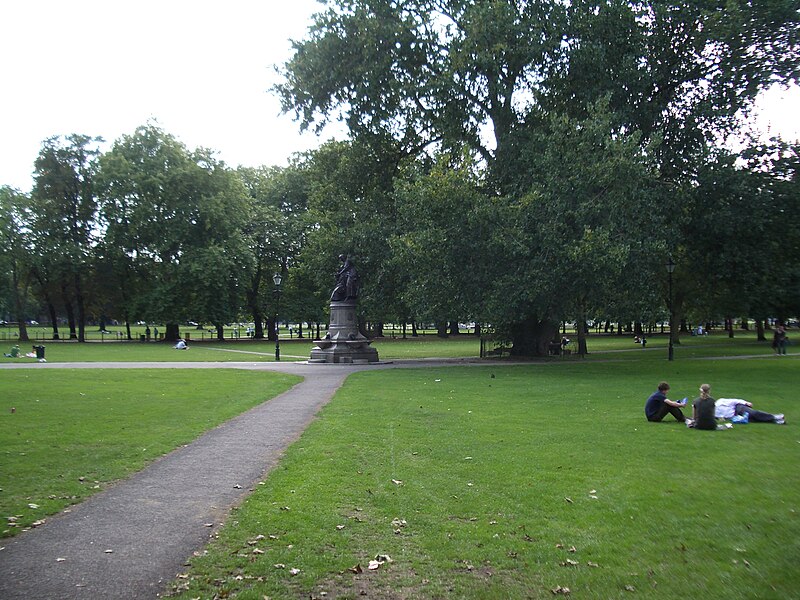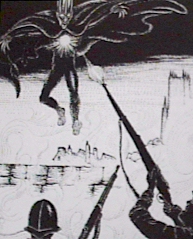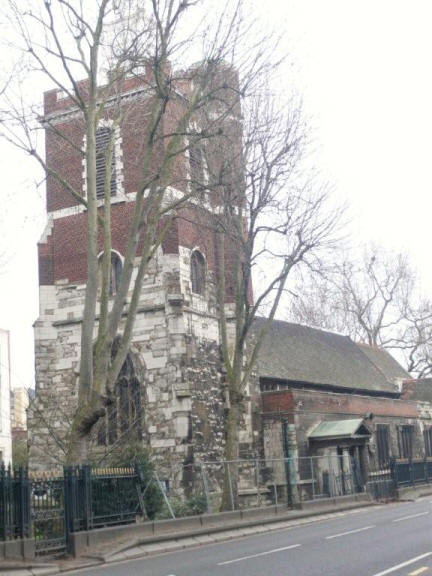The first alleged sightings of Spring-heeled Jack were made in London in 1837 and the last reported sighting is said in most of the secondary literature to have been made in Liverpool in 1904.

According to much later accounts, in October 1837, a girl by the name of Mary Stevens was walking to Lavender

Hill, where she was working as a servant, after visiting her parents in Battersea

. On her way through Clapham Common, a strange figure leapt at her from a dark alley.

After immobilising her with a tight grip of his arms, he began to kiss her face, while ripping her clothes and touching her flesh with his claws, which were, according to her deposition, "cold and clammy as those of a above old glory 15mm
above old glory 15mm
corpse". In panic, the girl screamed, making the attacker quickly flee from the scene. The commotion brought several residents who immediately launched a search for the aggressor, who could not be found.
 above old glory 15mm
above old glory 15mm corpse". In panic, the girl screamed, making the attacker quickly flee from the scene. The commotion brought several residents who immediately launched a search for the aggressor, who could not be found.

The next day, the leaping character is said to have chosen a very different victim near Mary Stevens' home, inaugurating a
here are some superquck buildings perfect for the uk of spring heeled jack. method that would reappear in later reports: he jumped in the way of a passing carriage,
method that would reappear in later reports: he jumped in the way of a passing carriage,
here are some superquck buildings perfect for the uk of spring heeled jack.
 method that would reappear in later reports: he jumped in the way of a passing carriage,
method that would reappear in later reports: he jumped in the way of a passing carriage,
causing the coachman to lose control, crash, and severely injure himself. Several witnesses claimed that he escaped by jumping over a nine-foot-high wall while babbling with a high-pitched, ringing laughter.

Gradually, the news of the strange character spread, and soon the press and the public gave him a name: Spring-heeled Jack
A few months after these first sightings, on January 9, 1838, the Lord Mayor of London, Sir John Cowan, revealed at a public session held in the Mansion House an anonymous complaint that he had received several days earlier, which he had withheld in the hope of obtaining further information. The correspondent, who signed the letter "a resident of Peckham", wrote:

A few months after these first sightings, on January 9, 1838, the Lord Mayor of London, Sir John Cowan, revealed at a public session held in the Mansion House an anonymous complaint that he had received several days earlier, which he had withheld in the hope of obtaining further information. The correspondent, who signed the letter "a resident of Peckham", wrote:

| “ | It appears that some individuals (of, as the writer believes, the highest ranks of life) have laid a wager with a mischievous and foolhardy companion, that he durst not take upon himself the task of visiting many of the villages near London in three different disguises — a ghost, a bear, and a devil; and moreover, that he will not enter a gentleman's gardens for the purpose of alarming the inmates of the house. The wager has, however, been accepted, and the unmanly villain has succeeded in depriving seven ladies of their senses, two of whom are not likely to recover, but to become burdens to their families. The wager has, however, been accepted, and the unmanly villain has succeeded in depriving seven ladies of their senses, two of whom are not likely to recover, but to become burdens to their families. At one house the man rang the bell, and on the servant coming to open door, this worse than brute stood in no less dreadful figure than a spectre clad most perfectly. The consequence was that the poor girl immediately swooned, and has never from that moment been in her senses. The affair has now been going on for some time, and, strange to say, the papers are still silent on the subject. The writer has reason to believe that they have the whole history at their finger-ends but, through interested motives, are induced to remain silent. Lucy  Scales was walking home with her sister from their brother's house along a lonely street in the Limehouse district. As they passed Green Dragon Alley, a tall cloaked figure bounded out of the shadows at them. He spat blue  flames into Lucy's face, blinding her. As she lay writhing on the ground, Spring-Heeled Jack calmly turned around and melted back into the shadows. Panic spread over the city of London. Up until now, the man's activities  had been centred around the surrounding towns and villages along the Thames. Word spread quickly: Spring-Heeled Jack was on the prowl in London itself!! He struck again a few nights later. The Alsop family was spending a quiet evening at home, when a violent knocking was heard at the front door. Jane Alsop (who lived with her father and her two sisters) got up to answer it.below army called out, the pentonville pissers to be exact When she opened the door she saw a man standing in the shadows near the front gate. He swung around. "I'm a police officer," he said. The miniatures shown below are citizens of the holloway road vigilantes who are looking for Jack, these are maybe the best miniaturea around since Willie. Empress Miniatures PO Bo Y OX28 9FH United Kingdo x 439 Minster Lovell WITNE  "For God's "For God'ssake, bring me a light, for we have caught Spring-Heeled Jack in the lane!" As Jane ran to fetch a candle, she thought how exciting it would be to see Spring-Heeled Jack arrested. When she gave the candle to the man at the gate, she realized she had made a terrible mistake, for the man applied to candle to his breast to reveal the hideous features of Spring-Heeled Jack  himself! Jane screamed as he vomited forth a huge amount of flame from his mouth. He then grabbed her and tore at her clothes with his sharp claws. She tried to get away, but the man caught her and continued his attack. the buildings here could easily represent london, they are made by empress, a great artitistic firm Soon the whole family ran out into the street, hearing her screams, but Spring-Heeled Jack bounded away down the road, and was soon lost to sight. Jane described her inhuman attacker to the police, saying that he wore a tight oilskin suit, and a kind of close-fitting helmet on his head (pictures of Spring-Heeled Jack portray him as wearing a mask with a pointed beard and pointed ears--like a devil) Spring-Heeled Jack made an aborted attempt at the same trick a few nights later at another house, but a servant boy realized who he was and began to shout for help. Spring-Heeled Jack escaped again, this time victimless. Throughout the 19th century, Spring-Heeled Jack was sighted all over England. After a brief period of inactivity in the late 1830's he was seen  time and time again in the 1840's and 50's. He frightened army sentries in the 1870's, by darting out of the darkness and slapping their faces with a cold, clammy hand before leaping onto the roofs of their sentry boxes. Angry townspeople shot at him in the streets on night in 1877. As usual, he laughed and melted away into the darkness, unrepentant.  Spring-Heeled Jack was last seen in 1904 in Liverpool. There, he terrified people by bounding up and down the streets and onto their rooftops. When attempts were made to corner him, but simply vanished into the darkness. This was the last reported sighting of Spring-Heeled Jack.  It is thought that the original Spring-Heeled Jack (for there was obviously more than one) was an Irish nobleman, The Marquis of Waterford, who was renowned for his sadistic taste in practical jokes, and his scorn for women. Author Peter Haining in his book "The Legend and Bizarre Crimes of  Spring-Heeled Jack" believes that Waterford's idea for the character of Jack was brought about by a humiliating experience with a woman and a police  officer while travelling abroad. Haining believes that Waterford and his rich friends thought up the idea as a prank to get even, by proxy, with the  police and women in general. Haining also believes that Waterford (who had friends who studied applied mechanics) helped him invent "spring-heeled  Legend has it (supported by an article in the London Examiner) that in the early hours of 6 April 1837 the Marquis of Waterford and his hunting party, while celebrating a particularly successful hunt, found several tins of red paint which they proceeded to daub on to the town’s toll bar and several buildings of the High Street.The Marquis of Waterford in question was actually Henry de la Poer Beresford. He was also known as ‘the Mad Marquis’, and according to the Oxford Dictionary of National Biography he was a ‘reprobate and landowner’. He is reported to have been ‘invited to leave’ Oxford University, and other recorded transgressions include fighting, stealing, being , breaking windows, upsetting apple-carts (literally), fighting duels and, last but not least, painting the heels of a parson’s horse with aniseed and then hunting him with bloodhounds. There are also suggestions that the Marquis of Waterford was ‘Spring Heeled Jack’ – a character who has gone into British Folklore and about whom I will write more on another occasion.In 1842, Lord Waterford married Louisa Stuart,  daughter of the 1st Baron Stuart de Rothesay, and settled in Curraghmore House in Ireland, and reportedly led an exemplary life, until he died in a horse riding accident in 1859. Spring Heeled Jack remained notionally active for decades after, which leads the aforementioned modern researchers to the same conclusion as Brewer's: Waterford may well have been responsible for the first attacks, while it was up to other pranksters who occasionally imitated him to continue the task. daughter of the 1st Baron Stuart de Rothesay, and settled in Curraghmore House in Ireland, and reportedly led an exemplary life, until he died in a horse riding accident in 1859. Spring Heeled Jack remained notionally active for decades after, which leads the aforementioned modern researchers to the same conclusion as Brewer's: Waterford may well have been responsible for the first attacks, while it was up to other pranksters who occasionally imitated him to continue the task.Whatever the origins – to this day, traces of red paint can be seen on doors of older buildings in the town.  boots" (boots with powerful springs in the heels) to help him with his attacks. It is likely that he also learned the technique of the fire-eater in order to heighten the supernatural aura of Spring-Heeled Jack.  In Inaddition, Waterford had strangely protuberent eyes, which matched the descriptions of Jack. He was also in the area when many of the attacks occured. As a final piece of evidence, the servant boy who scared Jack away saw a crest with the letter "W" on the man's cloak.  Although the mystery of Spring-Heeled Jack's identity has probably been ascertained, it is far more entertaining and romantic to think of Spring-Heeled Jack as a mysterious creature of the night who may someday leap from the shadows again. Springald, as he was also sometimes known, was without doubt the most famous 'bogeyman' of Victorian society, and enjoyed a status akin to that Bigfoot or 'little grey men' do today. He was also the first of his kind. While legends of strange phantoms have existed since the beginning of history, Spring Heeled Jack was the first to enter the official record as a real phenomenon, or at least as one whose witnesses could be found and would testify to the veracity of their experience. Part of this may have been due to the changing culture of the early nineteenth century, and the rise of mass printing technology, the first newspapers were largely responsible for the general publics awareness of the events, but there was also something unique about him. There were other similar changes at the time too, for instance the first identifiable witnesses to the infamous 'phantom horse and carriage' and the classic 'haunted mansion' also date to the early nineteenth century, perhaps for similar reasons, and even the aforementioned Bigfoot was first spotted in Canada in the mid 1830's according to some researchers, but none captured the public imagination as Jack did. He can in many ways be regarded as Britain's patron saint of weirdness.  According to others the actual events that led up to the beginning of the legend occurred in Barnes in early September 1837. According to newspaper reports, diligently researched by Mike Dash, in Fortean Studies Volume 3, the rumours of something spooky going on began with reports of women being attacked on country lanes in the vicinity of Barnes by an unknown creature. According to the Morning Chronicle a few months later, this creature turned out to be a 'white bull', though it is uncertain whether this refers to folklore of the devil appearing in the form of such a creature or whether it was literally a rogue farm animal. Similar stories exist in folklore of phantom 'white horses', and 'evil spirits' were widely regarded by country people of this time to take the form of dogs, cats, bears or lions, and particularly of a horned animal, often of a deep black or pale hue. But a little while later the local police in Brentford claimed to have identified the culprit as 'a white faced heifer' (Sept or Oct 1837 according to Morning Chronicle). This detail will become important in a moment. The panic was not allayed by this discovery and soon rumours of mysterious phantoms were heard from dozens of villages to the west of London. Another early form said to haven been taken by the phantom was a 'huge white bear' (which later on was more often a 'black bear') and one contemporary report talks of a mysterious 'baboon', but by October it was appearing in more human guise, particularly as it impinged on the outskirts of London itself. At this stage it is also described as a 'ghost', usually a figure in white clothes, often the now clichéd white sheet; or 'a devilish imp', with classical demonic features, and sometimes 'the devil himself'; or bizarrely 'an unearthly warrior in polished bronze armour', complete with strange clawed gloves. It was in these guises (and various combinations of them) that Jack moved into West London.The next victims of the phantom appear to have been the maids and servants of the large mansions on the outskirts of London, particularly in the areas of Hammersmith, Kensington and Ealing. In these accounts he would appear as a 'ghost, devil or bear', or any combination there of, either at the doors of suburban town houses, or in the gas lit streets around them. Servant girls were said to be reduced to hysterics by the very sight of him, with some allegedly 'dying of fright' on the spot. Children too were being terrorised by the phantom, with spurious rumours of infants being torn to shreds in country lanes (tales retold to unruly urchins of the Victorian period for long after). But contrary to popular myth it was not only young girls and children the phantom attacked. Late in 1837 at least three men were targeted in separate incidents. In Hammersmith an itinerant muffin man was attacked in Sounding-lane by a 'ghostly figure', who tore the clothes from his back; a blacksmith was severely injured by a phantom assailant with 'iron claws' in Ealing around the same time; and in Isleworth a carpenter called Jones was accosted in Cut-throat-lane by a figure in steel plate armour and garish red shoes. In the latter case Jones managed to get the better of his assailant, only to have two more 'ghosts' leap out of the bushes at him in assistance of their fellow spook. Jones was severely thrashed and his clothes torn to shreds. It is in these events we get the first inkling of a very human origin of the phenomena. Reports of the phantom began to spread in the winter of 1837, with assaults, or scares, alleged all over the western fringes of London, the phenomena soon spread south into Surrey,  and north into St Johns Wood and surrounding areas, eventually reaching Clapham, Dulwich, Camberwell and Peckham to the south of London. The panic was spreading like a contagion, but when reporters visited these areas few witnesses could be found, indicating that either they were scared to come forward or that much of the phenomena was an urban myth. It was in this period that the phantoms odd footwear began to be noticed with some speaking of the 'springs in his boots', implying, though not yet describing, extraordinary speed or agility. It was also around this time that rumours began to spread of a 'secret club' amongst the local gentry, who had laid a wager to scare a certain number of people witless in the London borders area within a short time span. and north into St Johns Wood and surrounding areas, eventually reaching Clapham, Dulwich, Camberwell and Peckham to the south of London. The panic was spreading like a contagion, but when reporters visited these areas few witnesses could be found, indicating that either they were scared to come forward or that much of the phenomena was an urban myth. It was in this period that the phantoms odd footwear began to be noticed with some speaking of the 'springs in his boots', implying, though not yet describing, extraordinary speed or agility. It was also around this time that rumours began to spread of a 'secret club' amongst the local gentry, who had laid a wager to scare a certain number of people witless in the London borders area within a short time span. |
 This should not be surprising as any glance at a map showing the spread of Jack reports reveals them spreading out north, south and east from Barnes before curving round pincer like on the east end from both sides. This area also saw the last events in the first wave of the scare, which can be fairly said to have climaxed here. Again the inititial focus was not in London itself but in villages to the east of the city, primarily Bromley by Bow,
This should not be surprising as any glance at a map showing the spread of Jack reports reveals them spreading out north, south and east from Barnes before curving round pincer like on the east end from both sides. This area also saw the last events in the first wave of the scare, which can be fairly said to have climaxed here. Again the inititial focus was not in London itself but in villages to the east of the city, primarily Bromley by Bow, a small hamlet amidst farm land on the main road between London and Essex. It was here that rumours of Jack's latest antics began to circulate, and sightings reported of a strange caped figure carrying a small lantern in
a small hamlet amidst farm land on the main road between London and Essex. It was here that rumours of Jack's latest antics began to circulate, and sightings reported of a strange caped figure carrying a small lantern in Bow Fair Fields (formerly the site of a local fair as the name implies). Similar sightings were reported from the nearby village of Old Ford (the original crossing of the Lea river, and its marshes, before the bow bridge was built at Bromley), as well as in a long quiet country road called Bearbinder Lane (now Tredegar Road).
Bow Fair Fields (formerly the site of a local fair as the name implies). Similar sightings were reported from the nearby village of Old Ford (the original crossing of the Lea river, and its marshes, before the bow bridge was built at Bromley), as well as in a long quiet country road called Bearbinder Lane (now Tredegar Road). It was at 1 Bearbinder Lane, on the 21 February around 8:45 in the evening, at the home of one of the areas most well to do families, that the most infamous Spring Heeled Jack encounter occurred. Jane Alsop, the 18 year old daughter of the then invalid John Alsop and his wife, was at home with her two sisters, when she heard an urgent ringing of the bell at the gate. On investigating it, a black cloaked figure in the path exclaimed, "I'm a policeman. For Gods sake, bring me a light, for we have caught Spring-heeled Jack here in the lane". Jane went to fetch a light for the man. She returned with a candle and as she was handing the light to the man, it shone on his face and she 'realised that it was Spring Heeled Jack'.
It was at 1 Bearbinder Lane, on the 21 February around 8:45 in the evening, at the home of one of the areas most well to do families, that the most infamous Spring Heeled Jack encounter occurred. Jane Alsop, the 18 year old daughter of the then invalid John Alsop and his wife, was at home with her two sisters, when she heard an urgent ringing of the bell at the gate. On investigating it, a black cloaked figure in the path exclaimed, "I'm a policeman. For Gods sake, bring me a light, for we have caught Spring-heeled Jack here in the lane". Jane went to fetch a light for the man. She returned with a candle and as she was handing the light to the man, it shone on his face and she 'realised that it was Spring Heeled Jack'.  The man is then said to have grabbed the candle and cast off his cloak, revealing him to be wearing a white oilskin-like coverall and large helmet which fitted him very tightly. His face was 'most hideous and frightful' according to Jane, and his eyes glowed a fiery red. Without warning he spat balls of a blue and white fire into her face, stunning her, before grabbing her neck and proceeding to assault her with his metallic claws. She attempted to run back into the house but he held her firmly in head lock and began tearing into her flesh and clothes with his claws. Freeing herself in the struggle she fled back up the stairs, but Jack held tightly to the back of her hair, ripping a large chunk of it from her head. Fortunately one of her sisters, alerted by her screams, managed to pull her out of his grasps and drag her back into the house, slamming the door in the phantoms face. Jack continued banging loudly on the door for some time, before hastily leaving when the family yelled for the police from the upper windows of the house.
The man is then said to have grabbed the candle and cast off his cloak, revealing him to be wearing a white oilskin-like coverall and large helmet which fitted him very tightly. His face was 'most hideous and frightful' according to Jane, and his eyes glowed a fiery red. Without warning he spat balls of a blue and white fire into her face, stunning her, before grabbing her neck and proceeding to assault her with his metallic claws. She attempted to run back into the house but he held her firmly in head lock and began tearing into her flesh and clothes with his claws. Freeing herself in the struggle she fled back up the stairs, but Jack held tightly to the back of her hair, ripping a large chunk of it from her head. Fortunately one of her sisters, alerted by her screams, managed to pull her out of his grasps and drag her back into the house, slamming the door in the phantoms face. Jack continued banging loudly on the door for some time, before hastily leaving when the family yelled for the police from the upper windows of the house. Unidentified witnesses claimed that Spring Heeled Jack left quickly, dropping his coat in a field by Jane's home. It was later also claimed that an 'accomplice' retrieved the cloak, but this is not mentioned in any contemporary report. The first definitely on the scene were a group from the nearby John Bull pub who had heard their cries for help, it was later said that they had passed a man in long black cloak on their way, who had told them to hurry to the scene as Spring Heeled Jack was at Mr Alsop's house and the police were needed. The family reported the event before magistrates at Lambeth Street, and a police investigation was launched which concluded the attack was genuine.
Unidentified witnesses claimed that Spring Heeled Jack left quickly, dropping his coat in a field by Jane's home. It was later also claimed that an 'accomplice' retrieved the cloak, but this is not mentioned in any contemporary report. The first definitely on the scene were a group from the nearby John Bull pub who had heard their cries for help, it was later said that they had passed a man in long black cloak on their way, who had told them to hurry to the scene as Spring Heeled Jack was at Mr Alsop's house and the police were needed. The family reported the event before magistrates at Lambeth Street, and a police investigation was launched which concluded the attack was genuine.  across the road from Millbank's residence, and alleged they had all but confessed to the crime to him before entering the pub.
across the road from Millbank's residence, and alleged they had all but confessed to the crime to him before entering the pub.  Both men denied this however, and claimed they had been attracted to the scene by the screams from the house. The publican of the White Hart Pub in Old Ford claimed they had in fact been on his premises at the time of the crime, though had left shortly after, and Millbank had bought a candle at a nearby store to light his way home, later found in his pocket (however it need be born in mind that clocks were not accurate, or well synchronised, in this period).
Both men denied this however, and claimed they had been attracted to the scene by the screams from the house. The publican of the White Hart Pub in Old Ford claimed they had in fact been on his premises at the time of the crime, though had left shortly after, and Millbank had bought a candle at a nearby store to light his way home, later found in his pocket (however it need be born in mind that clocks were not accurate, or well synchronised, in this period). 


No comments:
Post a Comment